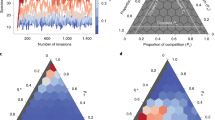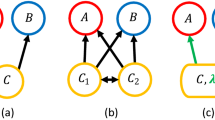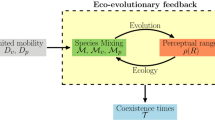Abstract
Ecologists seek to understand the rules that govern the assembly, coexistence and persistence of communities of interacting species. There is, however, a variety of sequences in which a multi-species community can be assembled—unlike more familiar one- and two-species systems. Ecological systems can exhibit contrasting dynamics depending on initial conditions1, but studies have been focused on simple communities initiated at different densities, not on multi-species communities constructed in different sequences. Investigations of permanence and convergence in ecological communities2,3,4 have been concerned with the flux of whole species (presence or absence)4 but have not addressed the central issues concerning the dynamics exhibited by individual species in particular interactions. Here we examine data for replicated three-species systems and demonstrate that the dynamic trajectories of both a predator and its prey within the system are determined by the sequence in which it is constructed, and that for one construction-sequence alternative dynamic patterns are possible.
This is a preview of subscription content, access via your institution
Access options
Subscribe to this journal
Receive 51 print issues and online access
$199.00 per year
only $3.90 per issue
Buy this article
- Purchase on Springer Link
- Instant access to full article PDF
Prices may be subject to local taxes which are calculated during checkout






Similar content being viewed by others
References
Cushing, J. M., Dennis, B., Desharnais, R. A. & Costantino, R. F. Moving towards an unstable equilibrium: saddle nodes in population systems. J. Anim. Ecol. 67, 298– 306 (1998).
Law, R. & Morton, R. D. Permanence and the assembly of ecological communities. Ecology 77, 762– 775 (1996).
Samuels, C. L. & Drake, J. A. Divergent perspectives on community convergence. Trends Ecol. Evol. 12, 427– 432 (1997).
Law, R. in Advanced Ecological Theory (ed. McGlade, J.) 143– 171 (Blackwell Science, Oxford, 1999).
Gurney, W. S. C. & Nisbet, R. M. Fluctuation periodicity, generation separation and the expression of larval competition. Theor. Popul. Biol. 28, 150– 180 (1985).
Sait, S. M., Begon, M. & Thompson, D. J. Long-term population dynamics of the Indian meal moth Plodia interpunctella and its granulosis virus. J. Anim. Ecol. 63, 861–870 (1994).
Begon, M., Sait, S. M. & Thompson, D. J. Predator–prey cycles with period shifts between two- and three-species systems. Nature 381, 311–315 (1996).
Bjørnstad, O. N. et al. Population dynamics of the Indian meal moth: demographic stochasticity and delayed regulatory mechanisms. J. Anim. Ecol. 67 , 110–126 (1998).
Sait, S. M., Begon, M. & Thompson, D. J. The effect of a sublethal baculovirus infection in the Indian meal moth, Plodia interpunctella. J. Anim. Ecol. 63, 541–550 ( 1994).
Begon, M., Sait, S. M. & Thompson, D. J. Persistence of a parasitoid-host system: refuges and generation cycles? Proc. R. Soc. Lond. B 260, 131–137 (1995).
Bjørnstad, O. N., Sait, S. M., Stenseth, N. C., Thompson, D. J. & Begon, M. Coupling strength controls the impact of specialised enemies on the dimension complexity of experimental moth dynamics. Nature (submitted).
May, R. M. & Hassell, M. P. The dynamics of multiparasitoid-host interactions. Am. Nat. 117, 234– 261 (1981).
Hochberg, M. E., Hassell, M. P. & May, R. M. The dynamics of host–parasitoid–pathogen interactions. Am. Nat. 135, 74– 94 (1990).
Rand, D. A. & Wilson, H. B. Chaotic stochasticity—a ubiquitous source of unpredictability in epidemics. Proc. R. Soc. Lond. B 246, 179–184 ( 1991).
Hastings, A. & Higgins, K. Persistence of transients in spatially structured ecological models. Science 263, 1133–1136 (1994).
Dennis, B., Desharnais, R. A., Cushing, J. M. & Costantino, R. F. Transitions in population dynamics: equilibria to periodic cycles to aperiodic cycles. J. Anim. Ecol. 66, 704– 729 (1997).
Briggs, C. J., Sait, S. M., Begon, M., Thompson, D. J. & Godfray, H. C. J. What causes generation cycles in populations of stored product moths? J. Anim. Ecol. 69, 352–366 (2000).
Sait, S. M., Begon, M. & Thompson, D. J. The influence of larval age on the response of Plodia interpunctella to a granulosis virus. J. Invertebr. Pathol. 63, 107–110 ( 1994).
Sait, S. M., Begon, M., Thompson, D. J., Harvey, J. A. & Hails, R. S. Factors affecting host selection in an insect host–parasitoid interaction. Ecol. Entomol. 22, 225–230 ( 1997).
Knell, R. J., Begon, M. & Thompson, D. J. Transmission of Plodia interpunctella granulosis virus does not conform to the mass action model. J. Anim. Ecol. 67, 592–599 ( 1998).
Godfray, H. C. J. & Hassell, M. P. Discrete and continuous insect populations in tropical environments. J. Anim. Ecol. 58, 153–174 ( 1989).
Gordon, D. M., Nisbet, R. M., De Roos, A., Gurney, W. S. C. & Stewart, R. R. Discrete generations in host-parasitoid models with contrasting life cycles. J. Anim. Ecol. 60, 295–308 (1991).
Chatfield, C. The Analysis of Time Series (Chapman & Hall, London, 1996)
Harvey, J. A., Harvey, I. F. & Thompson, D. J. Flexible larval growth allows use of a range of host sizes by a parasitoid wasp. Ecology 75, 1420–1428 (1994).
Gurney, W. S. C., Nisbet, R. M. & Lawton, J. H. The systematic formulation of tractable single-species population models incorporating age structure. J. Anim. Ecol. 52, 479–495 (1983).
Briggs, C. J. & Godfray, H. C. J. The dynamics of insect-pathogen interactions in stage-structured populations. Am. Nat. 145, 855–887 (1995).
Acknowledgements
We thank the NERC for funding this work, P. Rohani and O. Bjørnstad for helpful comments and constructive criticism of earlier versions of the manuscript.
Author information
Authors and Affiliations
Corresponding author
Rights and permissions
About this article
Cite this article
Sait, S., Liu, WC., Thompson, D. et al. Invasion sequence affects predator–prey dynamics in a multi-species interaction. Nature 405, 448–450 (2000). https://doi.org/10.1038/35013045
Received:
Accepted:
Issue Date:
DOI: https://doi.org/10.1038/35013045
This article is cited by
-
Networking for food production
Nature Sustainability (2022)
-
Proper Predation and Disease Transmission in Predator Population Stabilize Predator–Prey Oscillations
Differential Equations and Dynamical Systems (2020)
-
Complex dynamics and its stabilization in an eco-epidemiological model with alternative food
Modeling Earth Systems and Environment (2016)
-
Scale-dependent, contrasting effects of habitat fragmentation on host-natural enemy trophic interactions
Landscape Ecology (2015)
-
Effect of delay on a predator–prey model with parasitic infection
Nonlinear Dynamics (2011)
Comments
By submitting a comment you agree to abide by our Terms and Community Guidelines. If you find something abusive or that does not comply with our terms or guidelines please flag it as inappropriate.



